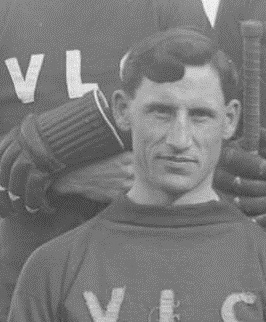
HARRY ROWELL GODFREY
(1880/1881 – April 12, 1941)
Vancouver Lacrosse Club (ca.1904-1913)
One of the most prevalent and frustrating aspects of researching lacrosse history in Canada is the sport’s heavy reliance on oral history. Stories and anecdotes that have been passed down word-of-mouth between the generations which are then later documented on to paper becoming ‘fact’ – and then the historian is left trying to sort out and make sense of all the inconsistencies that arise when these stories do not match.
When it comes to lacrosse played on the Coast, visual references such as film footage of lacrosse is essentially non-existent, with only a single-known, brief, blurry clip dating from before the 1920s. This forces historians to rely on the words of newspaper reports, photographs, and reminiscences of those who were there at the matches. While granted photographs are visual references, they are however but a singular instant captured in time and generally do not shed any clues as to the actual playing ability of the subjects in them.
With so many of the great lacrosse players from yesterday, while it has been passed along in generalised terms that such and such player was a great star or a fan favourite, we have very little factual data today to compare with their peers and show why they were so regarded. The inevitable passing of time ensured that a player obituary was written with little regard for accuracy and more focus on memorialising the deceased in the very best light. First-hand reminiscence and observations do have value when documented at the time of occurrence, but as time marches on, those memories grow old and fade and often start to diverge and contradict with the hard facts that do remain and can be confirmed.
When it comes to many of the early inductees in the Canadian Lacrosse Hall of Fame, we know perhaps two or three sentences about them – and nothing more. In regard to many players and people involved in the game a hundred years ago, we don’t even know when they were born nor in many cases when they died. It’s a serious, sad state of affairs but one we must grudgingly live with because historical preservation had different priorities and criteria decades ago. Obviously, the powers that be, in their day, viewed (and in many cases, knew firsthand) that these players had incredible, outstanding merits – but once acknowledging and honouring these individuals, practically no effort was then made to preserve the actual documentation and facts to keep their history alive and tell their unique stories to the generations to come.
The passing of time has created a whole collection of “he was one of the greatest…” players with their distinctions blurred, lost, and forgotten. The subsequent piecing together their stories from the various contradictory sources can often become a broken and misplaced jigsaw at times.

One such player is Harry Godfrey.
We are told he was a great player; the people in the lacrosse community who came before us saw him worthy enough to be inducted into the Canadian Lacrosse Hall of Fame in 1970, just five years after the hall was established.
Today, however, forty-five-plus years after his induction and over a century since he played his last game, we now do not know very much about him nor what drove his greatness. And when those scraps of facts which can be gleaned from newspapers and other sources are cobbled together, in the case of Harry Godfrey, the puzzle creates more contradictions and questions than it does assemble a clear picture. For such a well-known and well-regarded player in his day, the factual information about him is all over the place when it comes to the details.
Harry Rowell Godfrey was born in Winnipeg, Manitoba – and already starting with his birth we have contradictions with personal information, as there are at least three birthdates associated with him: March 21, 1880, August 14, 1880, and March 13, 1881. His gravestone at Mountainview cemetery in Vancouver shows just “1880-1941” and cemetery records list March 21, but the 1911 edition of C.W. Parker’s Who’s Who in Western Canada directory lists the latter of the three birthdate dates in the entry for Harry Godfrey.
We know nothing of him prior to his arrival in Vancouver in 1888 or 1900 – as, once again, sources vary on the year of that occurrence as well. His obituary in the newspaper quoted 1900 while Parker’s Who’s Who indicates he moved west as a child in 1888.
Godfrey did not start playing lacrosse, it is reported, until his arrival in the Terminal City and it has also been said that he was on the Vancouver YMCA senior team that traveled east in 1901 to challenge for the Minto Cup. This seems incredulous if he did arrive in Vancouver in 1900 with no playing experience.
Even more interesting, in May 1904, he was unanimously elected the club captain of the Vancouver Lacrosse Club – an impressive feat for a player with possibly only four years’ playing experience under his belt, and an event which earnt him mention in the press. These two events make one suspect whether he did have some exposure or playing experience prior to his relocation to Vancouver or whether 1888 is an accurate year for when he left Winnipeg.
We know he ran a sporting goods store, Harry R. Godfrey Gunsmiths & Sporting Goods, which was located first on Cordova Street and then later moved to 123 West Hastings. His business opened in 1902 or 1903 but had closed up shop by 1916. Amongst other items, his store sold lacrosse sticks to players of all ages and ability.
As for his playing ability, according to a newspaper article written at the time of his death in 1941, Godfrey was “…a big and wiry man,” who “…starred at home [i.e. midfield], and, later, defense. He was greatly respected by teammates and opposition both. After his playing days were over he was in the sporting goods business for many years, and later operated a mink farm in Burnaby.” Meanwhile The Spokesman-Review newspaper of Spokane, Washington specifically pointed him out in their review of the on-going 1907 Canadian lacrosse season him as Vancouver’s “husky inside home player”.
Outside of lacrosse, he excelled in basketball and had a keen interest in the YMCA organisation. In 1907 he married Viroqua E. Bonser and had at least one daughter and possibly more children.
Then there are the questionable facts which were later preserved but probably never verified – this is part of the oral history regarding Godfrey that was passed along from second- and third-hand sources. The classic but unsubstantiated ‘I knew a guy who knew a guy who knew or saw him play, and he said…’
According the biography written for Godfrey’s induction in the hall of fame, he played for “a number of school and junior teams” and that “he completed his field lacrosse career by playing ten years of senior lacrosse from 1907 to 1917 until the team disbanded because of the war.” Reading these words, what has happened, is a blurring of facts and dates due to the passage of time and memories.
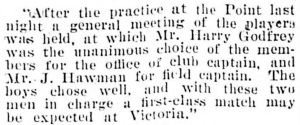
Based on more recent newspaper investigation, his playing career spanned a period starting no later than 1902 and ending no later than 1913. He played professional lacrosse from 1909 through 1913 with Vancouver Lacrosse Club – and due to the regulations at the time, there would have been no way Godfrey could have then been permitted to play senior (amateur) lacrosse after his professional career ended. Assuming he did regain his reinstatement as an amateur player, his name does not appear in game reports nor are there any photographs of him with the Vancouver Athletic Club, the senior amateur team of the day nor any other team for that matter. Both the VLC professional team and the VAC amateur team disbanded in 1915 and there was no organised or sanctioned lacrosse played in British Columbia during the war years of 1916 and 1917.
As for his alleged junior and school career which came before his senior career, it is difficult to determine when this would have occurred if he did not play any lacrosse prior to moving to Vancouver or if he did not move to Vancouver as a child. Since sources vary when he arrived in Vancouver, if it were the latter age of 20, in ca.1900, he would have been too old for the junior or scholastic leagues of the time. If he arrived on the Coast as a boy, then playing the game in his youth becomes much more feasible, believable, and probable.
Harry Godfrey passed away in 1941 and was interred at Mountain View Cemetery in Vancouver, memorialised on a Godfrey family headstone. He was inducted into the Canadian Lacrosse Hall of Fame in 1970.
(PHOTO SOURCES: CVA 99-35; CLHOF X979.145.1)
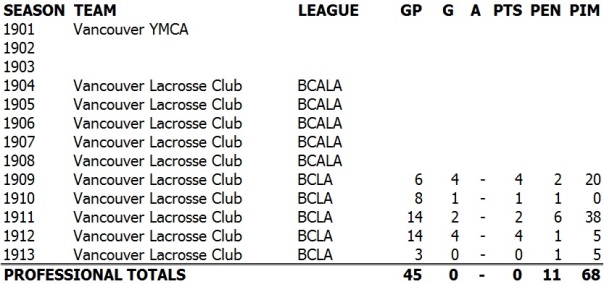

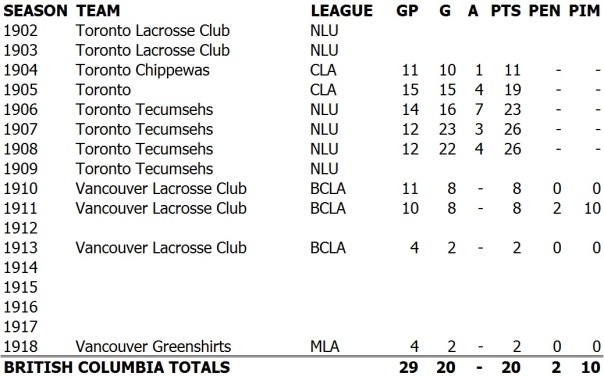
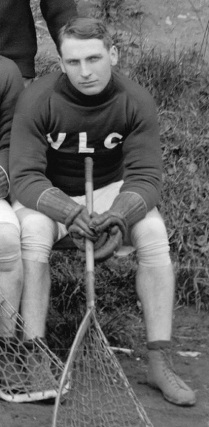
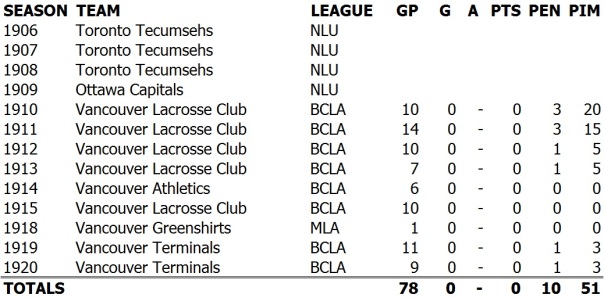
You must be logged in to post a comment.